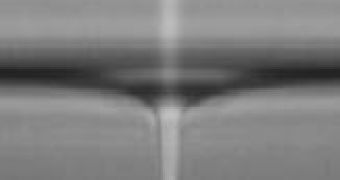Until now, the only known ways to move liquid were to apply pressure from a mechanical source, like an object or an other liquid or gas, but it seems that scientists have figured out how to create a jet of liquid with nothing but the power of light: they shined a laser beam through a soapy liquid, producing a long jet that eventually broke up into droplets after traversing a surprisingly long distance.
They know that the heat of lasers can set liquid in motion through heating effects, but this test, done in cooperation with French scientists at the University of Bordeaux, found that the light itself, not heat, did the pushing. "In previous work, people figured out that you can move individual particles with lasers," said Robert Schroll, graduate student in physics at the University of Chicago and lead author of the journal article. Now it appears that lasers can also be used to generate bulk flow in fluids. "As far as we know, we're the first to show this particular effect."
"I thought this was just so weird because I know when liquid is supposed to break up, and this one doesn't do so, instead light is actually pushing onto us slightly. This effect is called "radiation pressure," Zhang said.
Shampoo poured out of a bottle exists in one state. Add water and it turns into another state. The experimental liquid behaves similarly, except that he has rigged it to change its properties at 35 degrees Celsius (95 degrees Fahrenheit). Below 35 degrees Celsius, the liquid takes one form. Above that temperature, it separates into two distinct forms of differing density.
This is known as a "phase change." Many phase changes, like changing boiling water into Steam, are familiar in everyday life. The phase change that the Bordeaux group engineered in its laboratory is more exotic. As the soapy liquid approached the critical temperature, it took on a pearly appearance. This color change signaled the intense reflection, or scattering, of photons.
This gentle pressure generated by photons ordinarily goes unnoticed. But the liquid used in the Bordeaux experiment has such an incredibly weak surface that even light can deform it. "The photon will scatter off some part of the fluid, but moves away with the same energy that it came in with," Schroll explained. "This scattering effect is what's responsible for the flow that we see. Because the photon doesn't lose energy it doesn't transfer any energy into the fluid itself, so it doesn't cause any heating."
Further research may determine whether light-driven flow could provide a new twist to microfluidics, the science of controlling fluid flow through channels thinner than a human hair, for example in computer chips. "Here I've created a channel, but I didn't have to make anything. I just shined a light," Zhang said.

 14 DAY TRIAL //
14 DAY TRIAL //